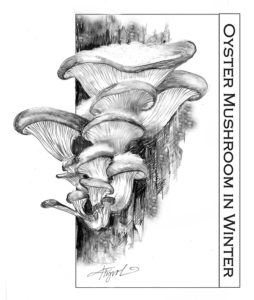By Frank Kaczmarek
Winter is far a far cry from being prime mushroom hunting season. Most fungi stop producing mushrooms, or fruiting bodies, in early autumn, and their hyphae (filamentous structures that are the main part of the fungal body) are out of sight, inside wood or in the ground. However, you can still find some specimens in winter. Spotting them is simply a matter of knowing where to look.
A few soft-bodied mushrooms, such as the prize edibles velvet foot and jelly ear, fruit from late autumn into early winter. Others, including the late fall oyster, blewits, and brick tops, will occasionally linger when mild weather persists, or will emerge in a thaw. You may also (more likely) find specimens of these fungi in desiccated form. The tough mushrooms of some shelf and bracket fungi – artist’s conk, crowded parchment and turkey tail, for example – persist year-round.

On a winter day with the temperature hovering in the low 20s and with several inches of snow covering the ground, I headed out on a mushroom hunting expedition. Almost immediately, I spotted a small mass of orange jelly on a downed hemlock log. Orange and yellow jellies (multiple species) aren’t actively growing now, but they’re remarkably durable and will expand back to their normal size during rain or snowmelt. I also discovered a batch of common crowded parchment on the opposite side of the trail.
On a nearby stump was a magnificent cluster of turkey tail, a year-round forest resident. This specimen’s fan-shaped caps sported alternating zones of color: white, tan, dark brown, grey, sky blue, and dark blue. While technically edible and traditionally used for teas, turkey tail fungus has garnered more interest recently for its possible uses in cancer treatments. Its leathery, striped caps are also prized by some jewelry makers who fashion them into earrings.
As the trail gently sloped uphill, I came across a large flush of orange mock oyster mushrooms on a downed log. Their bright 1- to 5-inch orange to orange-yellow, fan-shaped caps stood out against the snow. Again, this species isn’t actively growing now, but it’s worth a close look for its remarkably fuzzy surface. One sniff will tell you this isn’t edible; it has a sulfurous odor – à la spoiled cabbage or rotten eggs.
Farther up the trail, on the underside of a downed birch branch, I discovered a small grouping of luminescent panellus. This kidney-shaped, pale tan mushroom is highly bioluminescent during part of its life cycle, one of three species with this trait in the Northeast.
While crossing a small ridge, I came across two of the most common and conspicuous of the shelf and bracket fungi. Sprouting on a yellow birch were several horse hoof-shaped mushrooms, brown and gray in color: the tinder polypore. Ancient humans used the tinder polypore mushroom as tinder for fires (hence its common name) as well as for medicinal purposes. Nearby, a dead paper birch gave rise to a number of grayish-brown mushrooms characteristic of the birch polypore. This species’ historical applications have ranged from fuel to use as a razor strop to a de-worming agent.
As the walk progressed, my inventory of species increased to include four additional shelf and bracket fungi: cinnabar-red polypore, the lilac-edged violet-toothed polypore, artist’s conk, and the thin-mazed oak polypore. I also discovered several more jelly fungi, including the black and amber jelly-roll, along with a handful of crust-like fungi, including the common milk white polypore, zoned phlebia, and several others that I have yet to identify. My sightings also included, of course, the ubiquitous lemon drops.
As the saying goes, the best is saved for last, and near the trail’s end, a dead oak harbored several dozen tan-colored, fan-shaped fruiting bodies of the oyster mushroom. Along with being a prized edible, this fungus has an inherent ability to degrade polycyclic hydrocarbons – the major class of molecules found in oil – and has been used to clean up sites contaminated with diesel fuel.
Checking my list, I saw that I had come across nearly 20 different mushrooms – not bad for a winter walk through the woods.
Frank Kaczmarek is a photographer and retired biologist and author of “New England Wildflowers: A Guide to Common Plants,” a Falcon Field Guide published in 2009 by Globe-Pequot Press. He lives in Lyman, New Hampshire. Illustration by Adelaide Murphy Tyrol. The Outside Story is assigned and edited by Northern Woodlands magazine and sponsored by the Wellborn Ecology Fund of the New Hampshire Charitable Foundation: nhcf.org.




